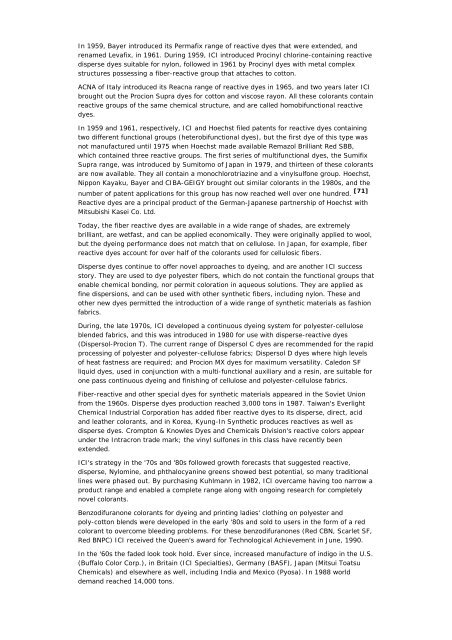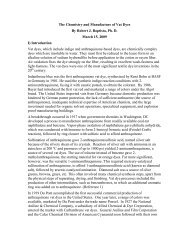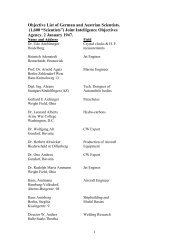International Dyestuff Industry - ColorantsHistory.Org
International Dyestuff Industry - ColorantsHistory.Org
International Dyestuff Industry - ColorantsHistory.Org
Create successful ePaper yourself
Turn your PDF publications into a flip-book with our unique Google optimized e-Paper software.
In 1959, Bayer introduced its Permafix range of reactive dyes that were extended, and<br />
renamed Levafix, in 1961. During 1959, ICI introduced Procinyl chlorine-containing reactive<br />
disperse dyes suitable for nylon, followed in 1961 by Procinyl dyes with metal complex<br />
structures possessing a fiber-reactive group that attaches to cotton.<br />
ACNA of Italy introduced its Reacna range of reactive dyes in 1965, and two years later ICI<br />
brought out the Procion Supra dyes for cotton and viscose rayon. All these colorants contain<br />
reactive groups of the same chemical structure, and are called homobifunctional reactive<br />
dyes.<br />
In 1959 and 1961, respectively, ICI and Hoechst filed patents for reactive dyes containing<br />
two different functional groups (heterobifunctional dyes), but the first dye of this type was<br />
not manufactured until 1975 when Hoechst made available Remazol Brilliant Red SBB,<br />
which contained three reactive groups. The first series of multifunctional dyes, the Sumifix<br />
Supra range, was introduced by Sumitomo of Japan in 1979, and thirteen of these colorants<br />
are now available. They all contain a monochlorotriazine and a vinylsulfone group. Hoechst,<br />
Nippon Kayaku, Bayer and CIBA-GEIGY brought out similar colorants in the 1980s, and the<br />
number of patent applications for this group has now reached well over one hundred. [71]<br />
Reactive dyes are a principal product of the German-Japanese partnership of Hoechst with<br />
Mitsubishi Kasei Co. Ltd.<br />
Today, the fiber reactive dyes are available in a wide range of shades, are extremely<br />
brilliant, are wetfast, and can be applied economically. They were originally applied to wool,<br />
but the dyeing performance does not match that on cellulose. In Japan, for example, fiber<br />
reactive dyes account for over half of the colorants used for cellulosic fibers.<br />
Disperse dyes continue to offer novel approaches to dyeing, and are another ICI success<br />
story. They are used to dye polyester fibers, which do not contain the functional groups that<br />
enable chemical bonding, nor permit coloration in aqueous solutions. They are applied as<br />
fine dispersions, and can be used with other synthetic fibers, including nylon. These and<br />
other new dyes permitted the introduction of a wide range of synthetic materials as fashion<br />
fabrics.<br />
During, the late 1970s, ICI developed a continuous dyeing system for polyester-cellulose<br />
blended fabrics, and this was introduced in 1980 for use with disperse-reactive dyes<br />
(Dispersol-Procion T). The current range of Dispersol C dyes are recommended for the rapid<br />
processing of polyester and polyester-cellulose fabrics; Dispersol D dyes where high levels<br />
of heat fastness are required; and Procion MX dyes for maximum versatility. Caledon SF<br />
liquid dyes, used in conjunction with a multi-functional auxiliary and a resin, are suitable for<br />
one pass continuous dyeing and finishing of cellulose and polyester-cellulose fabrics.<br />
Fiber-reactive and other special dyes for synthetic materials appeared in the Soviet Union<br />
from the 1960s. Disperse dyes production reached 3,000 tons in 1987. Taiwan's Everlight<br />
Chemical Industrial Corporation has added fiber reactive dyes to its disperse, direct, acid<br />
and leather colorants, and in Korea, Kyung-In Synthetic produces reactives as well as<br />
disperse dyes. Crompton & Knowles Dyes and Chemicals Division's reactive colors appear<br />
under the Intracron trade mark; the vinyl sulfones in this class have recently been<br />
extended.<br />
ICI's strategy in the '70s and '80s followed growth forecasts that suggested reactive,<br />
disperse, Nylomine, and phthalocyanine greens showed best potential, so many traditional<br />
lines were phased out. By purchasing Kuhlmann in 1982, ICI overcame having too narrow a<br />
product range and enabled a complete range along with ongoing research for completely<br />
novel colorants.<br />
Benzodifuranone colorants for dyeing and printing ladies' clothing on polyester and<br />
poly-cotton blends were developed in the early '80s and sold to users in the form of a red<br />
colorant to overcome bleeding problems. For these benzodifuranones (Red CBN, Scarlet SF,<br />
Red BNPC) ICI received the Queen's award for Technological Achievement in June, 1990.<br />
In the '60s the faded look took hold. Ever since, increased manufacture of indigo in the U.S.<br />
(Buffalo Color Corp.), in Britain (ICI Specialties), Germany (BASF), Japan (Mitsui Toatsu<br />
Chemicals) and elsewhere as well, including India and Mexico (Pyosa). In 1988 world<br />
demand reached 14,000 tons.





